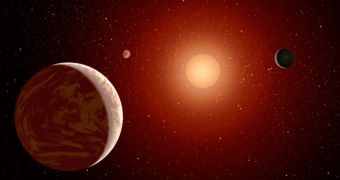Astronomers have recently discovered that red dwarfs feature much wider habitable zones around them than any other type of star. They are, on average, about 10 to 20 percent the mass of the Sun, and considerably dimmer, but apparently more likely to host a habitable extrasolar planet.
In addition to searching for exoplanets that may support life, investigators are currently also trying to find what type of star is more likely to have planets inside its habitable zone. The latter is an area around any star where temperatures are just right to support liquid water.
Some stars have a narrower habitable zone (Goldilocks zone) than others. The Sun's, for example, stretches from just outside the orbit of Venus to just before the orbit of Mars, featuring Earth right in its middle. This explains why our planet is the only one covered in water right now.
The Sun is a yellow dwarf star, average in size when compared to others out there. Red dwarfs are even smaller and darker, yet their habitable zones are wider than our parent star's. This means that the chances of an exoplanet developing within such an area are higher around such objects.
This is a very important finding, primarily because astronomers have discovered that red dwarfs are the dominant type throughout the Milky Way, but also because Earth-sized exoplanets living at those locations may very well be capable of supporting life as we know it, Space reports.
Red dwarfs make up about 80 percent of the galaxy, meaning that at least some of them theoretically have habitable exoplanets in orbit. New surveys are beginning to reveal the existence of very large numbers of exoplanets around such stars.
Only a fraction of them are located inside the habitable zone and, of those, only some are of sizes comparable to Earth's. However, as telescope technologies improve, it will become possible to detect smaller, rocky worlds with a lot more ease than currently possible.
“More of these planets are being found, so research is moving from being theoretical and predictive to using actual data from extrasolar planets,” University of East Anglia atmospheric physicist and study researcher Manoj Joshi explains.
“If a rocky planet forms around an M-star and it has water on it, if it gets cold enough, that'll turn to ice or snow. As for the odds of rocky planets forming around M-stars, Neptune- and sub-Neptune-sized objects have been found, so chances could be good,” he concludes.
Details of the new investigation appear in the January 23 issue of the esteemed journal Astrobiology.

 14 DAY TRIAL //
14 DAY TRIAL //